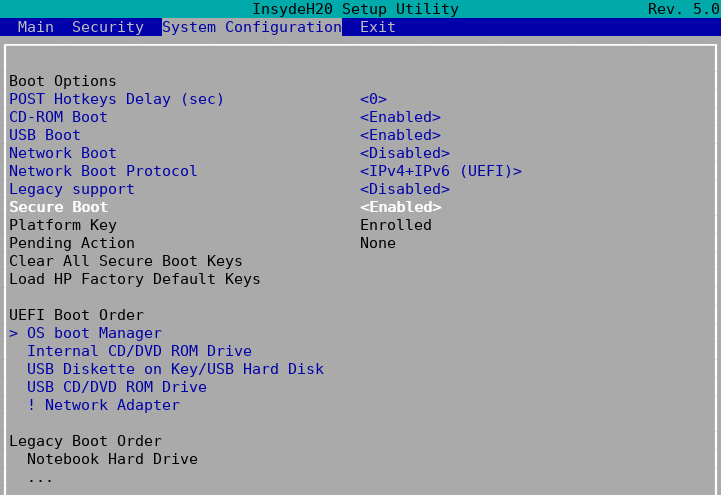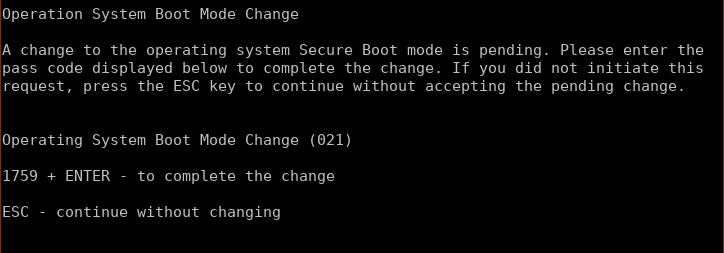This is an old revision of the document!
HOWTO create a SliTaz LiveUSB for 64bit UEFI computers
1. Preparing the USB stick
Open a terminal as the root user. Insert a USB stick in a USB port and type:

If not, replace all sdb1 occurrences with your device identification, ie: sdc1.
If the stick is not FAT32, format it (the packages dosfstools and mtool must be installed on your system):
# mkfs.vfat /dev/sdb1
All the data on the partition sdb1 will be destroyed.
Set the flags boot and lba to your stick:
# parted /dev/sdb set 1 boot on # parted /dev/sdb set 1 lba on
Don't pay attention to the message
Information: You may need to update /etc/fstab.
2. Creating the LiveUSB
Download the SliTaz Next ISO.
# wget http://mirror1.slitaz.org/iso/next/slitaz-next-170930.iso
No matter what the operating system is 32bit or 64bit. The important thing is that the boot loader is 64bit. Mount the stick:
# mount /dev/sdb1 /mnt
Mount the ISO file:
# mount -o loop slitaz-next-170930.iso /media/cdrom
Copy the files from the ISO to the stick:
# cp -r /media/cdrom/boot /mnt
Unmount the ISO:
# umount /media/cdrom
3. Installing an UEFI boot loader
You have now to install a boot loader compatible with UEFI; unfortunately, the grub2-efi package in the SliTaz repository is only for 32bit computers.
A simple way consists of using the boot loader from another 64bit distro ![]() . I used Ubuntu but it should exist within some other smaller ISOs.
Mount the dowloaded ISO:
. I used Ubuntu but it should exist within some other smaller ISOs.
Mount the dowloaded ISO:
# mount -o loop /path/to/file/distro-64bit.iso /media/cdrom
You should find the boot loader in the /efi/boot directory. Create a /efi/boot directory on your stick and copy the boot loader inside:
# mkdir -p /mnt/efi/boot # cp /media/cdrom/efi/boot/*.efi /mnt/efi/boot/bootx64.efi
The boot loader must imperatively be called bootx64.efi.
# mkdir -p /mnt/boot/grub # cp /media/cdrom/boot/grub/x86_64-efi /mnt/boot/grub
Unmount the ISO:
# umount /media/cdrom
4. Configuration file for GRUB 2
If you didn't create it at the previous step, create a /boot/grub directory on your stick:
# mkdir -p /mnt/boot/grub
With your preferred text editor (ie nano), create a configuration file for GRUB 2:
# nano /mnt/boot/grub/grub.cfg
The example below will be enough to boot the Live on a UEFI computer:
### CONFIGURATION FILE FOR GRUB 2 ###
#
# Comment the line if you want SliTaz to start automatically at boot or
# change the value to define the time (seconds) to wait before booting.
set TIMEOUT=-1
# Menu 0: boot SliTaz Next (20170930) in Live
menuentry "SliTaz Next (20170930)" {
set root=(hd0,1)
linux /boot/bzImage ro root=/dev/null video=-32 autologin
initrd /boot/rootfs.gz
}
5. Configuring the computer
Your Live is ready. But maybe the hardest remains to do.
Computers that came with Windows 8 / Windows 10 preinstalled start in Boot mode= UEFI and have the Secure boot= Enabled.
The Secure boot prevents the loading of drivers or OS loaders that are not signed with a digital signature ($old by Microsoft).
With SliTaz not having any digital signatures, you have to disable the secure boot.
The following lines describe how to do it on a hp Laptop 17-bs032 but it can different for you; there are almost as many ways as there are manufacturers / models of computers… ![]()
Even access to the Setup is different from one computer to another. If you don't know how to access to the setup, have a look here (sorry for french; I couldn't find an equivalent link in english). On the hp Laptop 17-bs032, press the [Esc] key immediately after you've powered on the computer until the screen displays the Startup Menu.

Press [F10] to access to the BIOS Setup. The Main page displays; use the right arrow to display the System Configuration page.

Select >Boot Options

If you're not sure or don't remember what you've done/changed, Exit Setup without saving!
Secure Boot and set it to Disabled.
Then, in UEFI Boot Order, place USB Diskette on Key/USB Hard Disk at the top of the list.

Well, it wasn't so hard. But we'll see in a next part that it is quite different on an acer Aspire v3-111p.
6. Run your Live
When Linux finds an hiberfil.sys file , it refuses to mount the partition. If you still try to access to the partition and worst if you wrote on it, you can corrupt the file system and Windows won't start anymore. You must disable the Fast Startup if you want to access your hard disk! But this HowTo is already long enough; I will explain this in the second part of UEFI and SliTaz.
Insert your Live in a USB port and restart the computer.
If you didn't modify the UEFI Boot Order - access the Multiboot menu (if you don't know what key of your computer gives access to the Multiboot menu, see here).
Plug your key in a non EFI (but 64bit) computer and… yes it boots too! (Well, at least on my Fujitsu E Series)
To enjoy the memory beyond 4GB
Create a LiveUSB with Rolling core64. But I'm quite sure it'll boot in console mode because kernel and modules are too old (or missing) for modern hardware. You'll have to find the driver for your graphics card and install it.
I've written these lines 7 months after I've done my UEFI LiveUSB. I hope I didn't make too many mistakes. If you encounter some problems with this HOWTO or find some errors in it please post at http://forum.slitaz.org/topic/grub2-efi-slitazs-package-and-uefi
To come:
HOWTO install SliTaz in frugal mode on a UEFI computer
| 2018/04/06 | Creation |
| Date | Modification |
|---|
